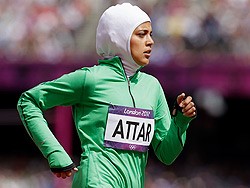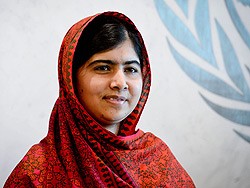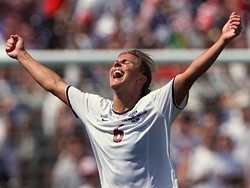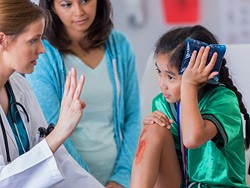In opening new opportunities for female athletes, Persian Gulf countries, including Saudi Arabia and Kuwait, have taken a step forward for democracy as well as sports. Sports physicians should encourage this trend.

Sarah Attar
Image from Anja Niedringhaus/AP
Saudi Arabia announced last month that women will be allowed as spectators and journalists in some of its largest sports stadiums. The move follows the kingdom's decision in 2012 to send its first female athletes to the Olympic Games. Girls in the kingdom will take physical education classes in school for the first time starting in 2018.
Meanwhile, Kuwait has launched women's basketball, table tennis, and athletic leagues for the first time.
These steps fall short of allowing equal participation in sports for women, but they show that progress is continuing to reverse a pattern of discrimination that stretches back over 2000 years.
History of Women's Participation in Sports
The Olympic Games of ancient Greece banned women both as participants and spectators, and men competed nude. The modern Olympic Games also excluded women when they started in 1894. But increased participation by women has paralleled advances in women's political rights. Women competed in tennis, sailing, croquet, equestrian sports, and golf in the Olympics of 1900, 11 years before the first-ever International Women's Day.

Malala Yousafzai
Image from Niu Xiaolei/Xinhua/Alamy
In 1928, athletic and gymnastic events opened to women in the Olympics, 8 years after women won the right to vote in the United States. Finally
in 2012, when boxing was opened to them, women had access to all the sports
available to men in the Olympics.
But the most important event in the history of women's sports in the
United States came in 1972, when
the Title IX law prohibited sex discrimination in all educational programs
receiving federal funds.[1]
That movement to educate and empower women continues to grow around the world, even in the face of resistance. The Malala Fund is one organization carrying on that work. It was named for Malala Yousafzai, who survived an assassination attempt as a teenager after advocating for girls' education in Pakistan. The fund has supported female athletes, such as Pakistani squash player Noorena Shams.
Empowerment of Women Through Sports
Not only do sports improve participants' health, they raise self-esteem[2] and boost academic performance.[3] In this way, they can help women gain economic independence and ensure success for their children.

Brandi Chastain
Image from Kevork Djansezian/AP
That's why when I served as chief medical officer for the Women's
World Cup in 1999, I felt I was part of the "coming out party"
for the empowerment of women.
The final attracted 90,185 spectators, the largest crowd of any event in
the history of women's sport.
Such events are milestones on the road toward full empowerment of women.
And I believe they can go a long way toward preventing the sexual harassment
and assaults that are currently dominating our headlines.
I'd love to see corporate sponsorships grow for women in sports; it offends me that the best female athletes attract exponentially less money than male athletes. Most of us can't do much about these market forces, but as sports physicians, we can do our part to make sure that our profession does the best it can for female athletes.
Training and Treating Injuries of Female Athletes
One of the most important considerations is the dynamic valgus alignment that characterizes the movements of many teenage girls. It increases the risk for knee injury, particularly anterior cruciate ligament rupture. Such programs as Prevent Injury and Enhance Performance and the International Football Federation' FIFA 11+ have shown success in strengthening the muscles surrounding and controlling the joint and training girls to run and jump with their knees neutrally aligned.[4]
We can help women empower themselves, and not only survive but thrive.
There is a close correlation between anterior cruciate ligament tears and osteoarthritis of the knee.[5]So preventing these knee injuries can afford lifetime benefits.
Concussions, too, are more common among female athletes. Researchers are now exploring whether programs aimed a neck strengthening can potentially make a difference in this statistic. In the meantime, sports physicians should pay particular attention to the recommendations of the Berlin Statement on Concussion in Sport[6] where our female athletes are concerned.

We should also watch for signs of the female athlete triad: low energy availability with or without disordered eating, menstrual dysfunction, and low bone mineral density.[7] Because they can make less estrogen, the bones of athletes with this syndrome may be weaker and more susceptible to stress fractures.
Lower age at menarche has been associated with an increased incidence of total knee replacement.[8]And low serum levels of endogenous estradiol, progesterone, and testosterone are associated with increased knee osteoarthritis.[9]
This problem needs greater attention. Perhaps even more than teenage girls, postmenopausal women could benefit from increased physical activity. Too often, as these women try to participate in sports, their cartilage begins to break down. This can create a vicious cycle in which reduced physical activity causes weight gain and increased stress on joints—causing more arthritis and further reducing physical activity.
When I suspect that these factors are in play, I refer my patients to specialists who can guide them in the decision whether or not to undertake hormone replacement therapy, balancing the benefits against the risks.
But whatever challenges these hormonal changes present, it's important to remember that women on average are no less capable of physical activity than men. In fact, women in the United States outlive men by an average of 5 years, which may say something about their resilience.
I counsel all of my patients to stay as physically active as possible, regardless of gender and hormone status. For my older patients, I particularly recommend walking, hiking, yoga, Pilates, and weight lifting as part of a program to manage osteopenia and sarcopenia. In these ways, we can help women empower themselves, and not only survive but thrive.
Follow Medscape Orthopedics on Twitter for more orthopedics and sports medicine news: @MedscapeOrtho
References
- Title IX and sex discrimination. US Department of Education. April 29, 2015. https://www2.ed.gov/about/offices/list/ocr/docs/tix_dis.html Accessed November 17, 2017.
- Liu M, Wu L, Ming Q. How does physical activity intervention improve self-esteem and self-concept in children and adolescents? Evidence from a meta-analysis. PLoS One. 2015;10:e0134804.
- Shifrer D, Pearson J, Muller C, Wilkinson L. College-going benefits of high school sports participation: race and gender differences over three decades. Youth Soc. 2015;47:295-318. Abstract
- Soligard T, Myklebust G, Steffen K, et al. Comprehensive warm-up programme to prevent injuries in young female footballers: cluster randomised controlled trial. BMJ. 2008;337:a2469.
- Cinque ME, Dornan GJ, Chahla J, Moatshe G, LaPrade RF. High rates of osteoarthritis develop after anterior cruciate ligament surgery: an analysis of 4108 patients. Am J Sports Med. 2017 Sep 1. [Epub ahead of print]
- McCrory P, Meeuwisse W, Dvoøák J, et al. Consensus statement on concussion in sport-the 5th international conference on concussion in sport held in Berlin, October 2016. Br J Sports Med. 2017;51:838-847. Abstract
- Brown KA, Dewoolkar AV, Baker N, Dodich C. The female athlete triad: special considerations for adolescent female athletes. Transl Pediatr. 2017;6:144-149. Abstract
- Hellevik AI, Nordsletten L, Johnsen MB, et al. Age of menarche is associated with knee joint replacement due to primary osteoarthritis (The HUNT Study and the Norwegian Arthroplasty Register). Osteoarthritis Cartilage. 2017;25:1654-1662. Abstract
- Jin X, Wang BH, Wang X, et al. Associations between endogenous sex hormones and MRI structural changes in patients with symptomatic knee osteoarthritis. Osteoarthritis Cartilage. 2017;25:1100-1106. Abstract
Medscape Orthopedics © 2017 WebMD, LLC
Any views expressed above are the author's own and do not necessarily reflect the views of WebMD or Medscape.
